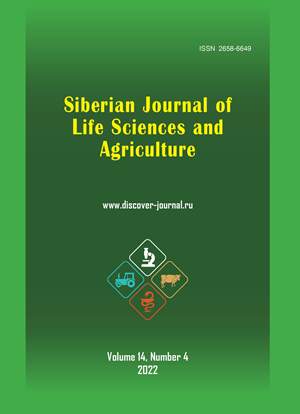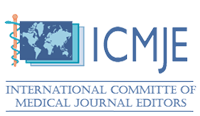ОЦЕНКА ПОТРЕБИТЕЛЬСКИХ КАЧЕСТВ ПЛОДОВ ОТБОРНЫХ ФОРМ ЗЕМЛЯНИКИ САДОВОЙ (FRAGARIA × ANANASSA DUCH.)
Аннотация
Улучшение биохимического состава и аромата плодов является актуальной задачей совершенствования сортимента земляники, так как немногие из современных сортов сочетают высокий уровень качества и аромата плодов с повышенным накоплением компонентов биохимического состава. Цель исследования – анализ гибридных сеянцев земляники по комплексу потребительских качеств плодов для выделения перспективных генотипов. Оценку привлекательности и вкусовых качеств плодов проводили органолептически, содержание биохимических компонентов – в лабораторных условиях по стандартным методикам, аромата плодов – с использованием ДНК-маркеров.
В результате проведённых исследований идентифицированы перспективные генотипы, характеризующиеся высоким уровнем проявления комплекса признаков: 75-30 (Tokado × Elianny) – привлекательность (5,0 балла), вкус плодов (4,5 балла), содержание растворимых сухих веществ (РСВ) (9,2% Brix) и витамина C (72,1 мг/100 г); 34-2 (922-67 × Привлекательная) – привлекательность (5,0 балла), аромат плодов (ген FaOMT), вкус (4,5 балла), содержание РСВ (14,7% Brix) и сахаров (10,8%); 153-41 (Senga Sengana × Redcoat) – привлекательность (5,0 балла), аромат плодов (ген FaOMT), содержание РСВ (12,8% Brix), сахаров (10,2%) и витамина C (76,1 мг/100 г); 153-60 (Senga Sengana × Redcoat) – привлекательность (5,0 балла), аромат плодов (ген FaOMT), вкус (4,6 балла), содержание РСВ (11,7% Brix) и сахаров (10,5%); 35-16 (922-67 × Maryshka) – вкус плодов (4,6 балла) и содержание антоцианов (90,7 мг/100 г); 72-25 (Привлекательная × Былинная) – комбинация генов аромата плодов FaOMT и FaFAD1.
Скачивания
Литература
References
Ermakov A. I., Arasimovich V. V., Yarosh N. P. Metody Biokhimicheskogo Issledovaniya Rasteniy [Biochemical Research Methods of Plants]. Leningrad: Kolos, 1987, 429 p.
Zhbanova E. V., Luk’yanchuk I. V., Bogdanova O. A. Biokhimicheskiy sostav gibridnykh seyantsev i otbornykh zemlyanikov [Biochemical composition of berries of hybrid seedlings and selected forms of strawberries]. Izvestiya Timiryazevskoy Selskokhozyaystvennoy Akademii [Bulletin of Timiryazev Agricultural Academy], 2009, vol. 4, pp. 124–128.
Zubov A. A. Teoreticheskiye Osnovy Selektsii Zemlyaniki [Theoretical Foundations of Strawberry Breeding]. Michurinsk: All-Russian Research Institute of Horticulture Named After IV Michurin, 2004, 196 p.
Luk’yanchuk I. V., Zhbanova E. V. Otsenka geneticheskoy kollektsii zemlyaniki po soderzhaniyu v plodakh antotsianov [Assessment of the genetic collection of strawberries by the content of anthocyanins in berries]. Vestnik Tomskogo Gosudarstvennogo Universiteta. Biologiya [Bulletin of Tomsk State University. Biology], 2017, vol. 38, pp. 134–148. https://doi.org/10.17223/19988591/38/8
Lyzhin A. S., Luk’yanchuk I. V., Zhbanova E. V. Polimorfizm sortov i dikorastushchikh vidov zemlyaniki geneticheskoy kollektsii Federal’nogo nauchnogo tsentra im. I.V. Michurina po genam aromata plodov FaOMT i FaFADl [Polymorphism of the FaOMT and FaFAD1 genes for fruit flavor volatiles in strawberry varieties and wild species from the genetic collection of the Michurin Federal Research Center]. Vavilovskiy Zhurnal Genetiki i Selektsii [Vavilov Journal of Genetics and Breeding], 2020, vol. 24, no. 1, pp. 5–11. https://doi.org/10.18699/VJ20.588
Akimov M. Yu., Luk’yanchuk I. V., Zhbanova E. V., Lyzhin A. S. Plody zemlyaniki sadovoy (Fragaria × ananassa Duch.) kak tsennyy istochnik pishchevykh i biologicheski aktivnykh veshchestv (obzor) [Strawberry fruit (Fragaria × ananassa Duch.) as a valuable source of nutritional and biologically active substances (review)]. Khimiya Rastitel’nogo Syr’ya, 2020, vol. 1, pp. 5–18. https://doi.org/10.14258/jcprm.2020015511
Rukovodstvo po metodam kontrolya kachestva i bezopasnosti biologicheski aktivnykh dobavok k pishche R 4.1.1672-03, 2003 g [Guidelines for quality control and safety of dietary supplements R 4.1.1672-03, 2003]. URL: https://docs.cntd.ru/document/1200034795
Sedov E. N., Ogoltsova T. P. Programma i Metodika Sortoizucheniya Plodovykh, Yagodnykh i Orekhoplodnykh Kul’tur [Program and Methods of Variety Research on Fruit, Berry, and Nut Crops]. Orel: VNIISPK, 1999, 606 p.
Basu A., Nguyen A., Betts N. M., Lyons T. J. Strawberry as a functional food: An evidence-based review. Critical Reviews in Food Science and Nutrition, 2014, vol. 54, no. 6, pp. 790–806. http://dx.doi.org/10.1080/10408398.2011.608174
Bianchi G., Lucchi P., Maltoni M. L., Fagherazzi A., Baruzzi G. Analysis of aroma compounds in new strawberry advanced genotypes. Acta Horticulturae, 2017, vol. 1156, pp. 673–678. http://dx.doi.org/10.17660/ActaHortic.2017.1156.98
Capocasa F., Scalzo J., Mezzetti B., Battino M. Combining quality and antioxidant attributes in the strawberry: The role of genotype. Food Chemistry, 2008, vol. 111, no. 4, pp. 872–878. http://dx.doi.org/10.1016/j.foodchem.2008.04.068
Chambers A. H., Pillet J., Plotto A., Bai J., Whitaker V. M., Folta K. Identification of a strawberry flavor gene candidate using an integrated genetic-genomic-analytical chemistry approach. BMC Genomics, 2014, vol. 15, no. 1, 217. http://dx.doi.org/10.1186/1471-2164-15-217
Cruz-Rus E., Sesmero R., Ángel-Pérez J. A., Sánchez-Sevilla J. F., Ulrich D., Amaya I. Validation of a PCR test to predict the presence of flavor volatiles mesifurane and γ-decalactone in fruits of cultivated strawberry (Fragaria × ananassa). Molecular Breeding, 2017, vol. 37, no. 10, pp. 131. https://link.springer.com/article/10.1007/s11032-017-0732-7
Fernández-Lara R., Gordillo B., Rodríguez-Pulido F. J. M, González-Miret L., Del Villar-Martínez A. A., Dávila Ortiz G., Heredia F. J. Assessment of the differences in the phenolic composition and color characteristics of new strawberry (Fragaria × ananassa Duch.) cultivars by HPLC-MS and imaging tristimulus colorimetry. Food Res Int, 2015, vol. 76, pp. 645–653. http://dx.doi.org/10.1016/j.foodres.2015.07.038
Giampieri F., Forbes T., Gasparrini M., Afrin S., Cianciosi D., Reboredo-Rodríguez P., Varela-López A., Quiles J. L., Mezzetti B., Battino M. The healthy effects of strawberry bioactive compounds on molecular pathways related to chronic diseases. Annals of the New York Academy of Sciences, 2017, vol. 1398, no. 1, pp. 62–71. http://dx.doi.org/10.1111/nyas.13373
Luk’yanchuk I. Molecular genetic analysis of strawberry genotypes for the FaOMT fruit aroma gene. BIO Web of Conferences, 2020, vol. 25, e03003. http://dx.doi.org/10.1051/bioconf/20202503003
Schwieterman M. L., Colquhoun T. A., Jaworski E., Bartoshuk L. M., Gilbert J. L., Tieman D. M., Odabasi A. Z., Moskowitz H., Folta K., Klee H. J., Sims C. A., Whitaker V. M., Clark D. G. Strawberry flavor: Diverse chemical compositions, a seasonal influence, and effects on sensory perception. PloS One, 2014, vol. 9, no. 2, e88446. http://dx.doi.org/10.1371/journal.pone.0088446
Singh A., Singh B. K., Deka B. C., Deka B. C., Sanwal S., Patel R., Verma M. R. The genetic variability, inheritance and inter-relationships of ascorbic acid, carotene, phenol and anthocyanin content in strawberry (Fragaria × ananassa Duch.). Scientia Horticulturae, 2011, vol. 129, pp. 86–90. http://dx.doi.org/10.1016/j.scienta.2011.03.011
Song C., Hong X., Zhao S., Liu J., Schulenburg K., Huang F.-C., Franz-Oberdorf K., Schwab W. Glucosylation of 4-Hydroxy-2,5-Dimethyl-3(2H)-Furanone, the key strawberry flavor compound in strawberry fruit. Plant Physiol, 2016, vol. 171, no. 1, pp. 139–151. https://doi.org/10.1104/pp.16.00226
Ulrich D., Olbricht K. A search for the ideal flavor of strawberry – Comparison of consumer acceptance and metabolite patterns in Fragaria × ananassa duch. Journal of Applied Botany and Food Quality, 2016, vol. 89, pp. 223–234. http://dx.doi.org/10.5073/JABFQ.2016.089.029
Urrutia M., Rambla J. L., Alexiou K. G., Granell A., Monfort A. Genetic analysis of the wild strawberry (Fragaria vesca) volatile composition. Plant Physiol Bioch, 2017, vol. 121, pp. 99–117. https://doi.org/10.1016/j.plaphy.2017.10.015
Zorrilla-Fontanesi Y., Rambla J. L., Cabeza A., Medina-M’inguez J. J. J., Sánchez J. F., Valpuesta V., Botella M. A., Granell A., Amaya I. Genetic analysis of strawberry fruit aroma and identification of O-methyltransferase FaOMT as the locus controlling natural variation in mesifurane content. Plant Physiology, 2012, vol. 159, no. 2, 851–870. http://dx.doi.org/10.1104/pp.111.188318
Список литературы
Ермаков А. И., Арасимович В. В., Ярош Н. П. Методы биохимического исследования растений. Л.: Колос, 1987. 429 с.
Жбанова Е. В., Лукъянчук И. В., Богданова О. А. Биохимический состав ягод гибридных сеянцев и отборных форм земляники // Известия Тимирязевской сельскохозяйственной академии. 2009. № 4. С. 124–128.
Зубов А. А. Теоретические основы селекции земляники. М.: Изд-во ВНИИГиСПР им. И. В. Мичурина, 2004. 196 с.
Лукъянчук И. В., Жбанова Е. В. Оценка генетической коллекции земляники по содержанию в плодах антоцианов // Вестник Томского государственного университета. Биология. 2017. № 38. С. 134–148. https://doi.org/10.17223/19988591/38/8
Лыжин А. С., Лукъянчук И. В., Жбанова Е. В. Полиморфизм сортов и дикорастущих видов земляники генетической коллекции Федерального научного центра им. И.В. Мичурина по генам аромата плодов FaOMT и FaFADl // Вавиловский журнал генетики и селекции. 2020. Т. 24. № 1. С. 5–11. https://doi.org/10.18699/VJ20.588
Плоды земляники садовой (Fragaria × ananassa Duch.) как ценный источник пищевых и биологически активных веществ (обзор) / Акимов М. Ю., Лукъянчук И. В., Жбанова Е. В., Лыжин А. С. // Химия растительного сырья. 2020. №1. С. 5–18. https://doi.org/10.14258/jcprm.2020015511
Руководство по методам контроля качества и безопасности биологически активных добавок к пище Р 4.1.1672-03, 2003 г. URL: https://docs.cntd.ru/document/1200034795
Седов Е. Н., Огольцова Т. П. Программа и методика сортоизучения плодовых, ягодных и орехоплодных культур. О.: ВНИИСПК, 1999. 606 с.
Basu A., Nguyen A., Betts N. M., Lyons T. J. Strawberry as a functional food: An evidence-based review // Critical reviews in food science and nutrition, 2014, vol. 54, no. 6, pp. 790–806. http://dx.doi.org/10.1080/10408398.2011.608174
Bianchi G., Lucchi P., Maltoni M. L., Fagherazzi A., Baruzzi G. Analysis of aroma compounds in new strawberry advanced genotypes // Acta Horticulturae, 2017, vol. 1156, pp. 673–678. http://dx.doi.org/10.17660/ActaHortic.2017.1156.98
Capocasa F., Scalzo J., Mezzetti B., Battino M. Combining quality and antioxidant attributes in the strawberry: The role of genotype // Food chemistry, 2008, vol. 111, no. 4, pp. 872–878. http://dx.doi.org/10.1016/j.foodchem.2008.04.068
Chambers A. H., Pillet J., Plotto A., Bai J., Whitaker V. M., Folta K. Identification of a strawberry flavor gene candidate using an integrated genetic-genomic-analytical chemistry approach // BMC genomics, 2014, vol. 15, no. 1, 217. http://dx.doi.org/10.1186/1471-2164-15-217
Cruz-Rus E., Sesmero R., Ángel-Pérez J. A., Sánchez-Sevilla J. F., Ulrich D., Amaya I. Validation of a PCR test to predict the presence of flavor volatiles mesifurane and γ-decalactone in fruits of cultivated strawberry (Fragaria × ananassa) // Molecular breeding, 2017, vol. 37, no. 10, pp. 131. https://link.springer.com/article/10.1007/s11032-017-0732-7
Fernández-Lara R., Gordillo B., Rodríguez-Pulido F. J. M, González-Miret L., Del Villar-Martínez A. A., Dávila Ortiz G., Heredia F. J. Assessment of the differences in the phenolic composition and color characteristics of new strawberry (Fragaria × ananassa Duch.) cultivars by HPLC-MS and imaging tristimulus colorimetry // Food res int, 2015, vol. 76, pp. 645–653. http://dx.doi.org/10.1016/j.foodres.2015.07.038
Giampieri F., Forbes T., Gasparrini M., Afrin S., Cianciosi D., Reboredo-Rodríguez P., Varela-López A., Quiles J. L., Mezzetti B., Battino M. The healthy effects of strawberry bioactive compounds on molecular pathways related to chronic diseases // Annals of the New York academy of sciences, 2017, vol. 1398, no. 1, pp. 62–71. http://dx.doi.org/10.1111/nyas.13373
Luk’yanchuk I. Molecular genetic analysis of strawberry genotypes for the FaOMT fruit aroma gene // BIO web of conferences, 2020, vol. 25, e03003. http://dx.doi.org/10.1051/bioconf/20202503003
Schwieterman M. L., Colquhoun T. A., Jaworski E., Bartoshuk L. M., Gilbert J. L., Tieman D. M., Odabasi A. Z., Moskowitz H., Folta K., Klee H. J., Sims C. A., Whitaker V. M., Clark D. G. Strawberry flavor: Diverse chemical compositions, a seasonal influence, and effects on sensory perception // PloS one, 2014, vol. 9, no. 2, e88446. http://dx.doi.org/10.1371/journal.pone.0088446
Singh A., Singh B. K., Deka B. C., Deka B. C., Sanwal S., Patel R., Verma M. R. The genetic variability, inheritance and inter-relationships of ascorbic acid, carotene, phenol and anthocyanin content in strawberry (Fragaria × ananassa Duch.) // Scientia Horticulturae, 2011, vol. 129, pp. 86–90. http://dx.doi.org/10.1016/j.scienta.2011.03.011
Song C., Hong X., Zhao S., Liu J., Schulenburg K., Huang F.-C., Franz-Oberdorf K., Schwab W. Glucosylation of 4-Hydroxy-2,5-Dimethyl-3(2H)-Furanone, the key strawberry flavor compound in strawberry fruit // Plant physiol, 2016, vol. 171, no. 1, pp. 139–151. https://doi.org/10.1104/pp.16.00226
Ulrich D., Olbricht K. A search for the ideal flavor of strawberry – Comparison of consumer acceptance and metabolite patterns in Fragaria × ananassa duch // Journal of applied botany and food quality, 2016, vol. 89, pp. 223–234. http://dx.doi.org/10.5073/JABFQ.2016.089.029
Urrutia M., Rambla J. L., Alexiou K. G., Granell A., Monfort A. Genetic analysis of the wild strawberry (Fragaria vesca) volatile composition // Plant physiol bioch, 2017, vol. 121, pp. 99–117. https://doi.org/10.1016/j.plaphy.2017.10.015
Zorrilla-Fontanesi Y., Rambla J. L., Cabeza A., Medina-M’inguez J. J. J., Sánchez J. F., Valpuesta V., Botella M. A., Granell A., Amaya I. Genetic analysis of strawberry fruit aroma and identification of O-methyltransferase FaOMT as the locus controlling natural variation in mesifurane content // Plant physiology, 2012, vol. 159, no. 2, 851–870. http://dx.doi.org/10.1104/pp.111.188318
Просмотров аннотации: 191 Загрузок PDF: 128
Copyright (c) 2023 Irina V. Luk’yanchuk, Ekaterina V. Zhbanova, Alexander S. Lyzhin

Это произведение доступно по лицензии Creative Commons «Attribution-NonCommercial-NoDerivatives» («Атрибуция — Некоммерческое использование — Без производных произведений») 4.0 Всемирная.






















































